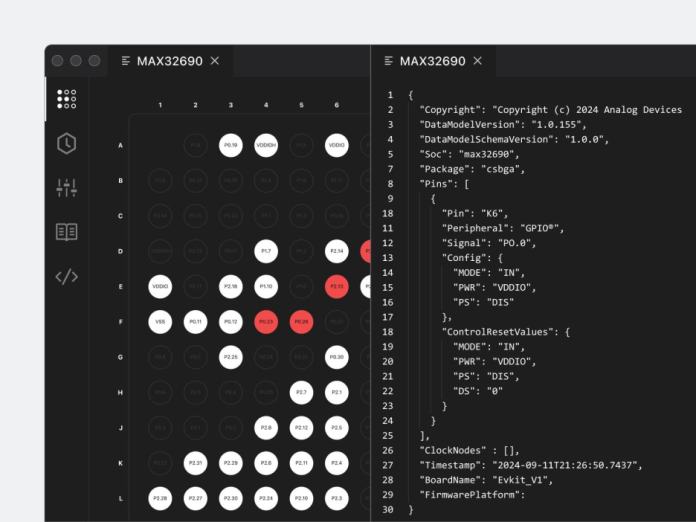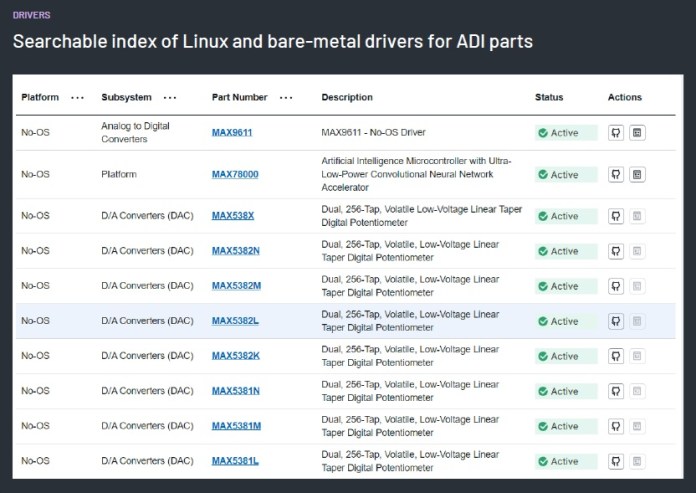Analog Devices, Inc. (ADI) has launched its inaugural suite of developer offerings that bring together devices, hardware, software and services for the intelligent edge. The suite of new embedded solutions include ADI’s new CodeFusion Studio, an embedded software development environment combined with advanced security, and a new developer portal, ADI Developer.
The solution addresses the increasing complexity of developing embedded software as the industry moves to multi-core and multi-architecture devices with an open-source development environment that leverages widely used communities, such as Zephyr and Linux with broad ecosystems.
Built on open-source solutions, CodeFusion Studio, based on Microsoft’s Visual Studio code, is ADI’s first fully integrated suite of software and security solutions. CodeFusion Studio comprises three core components: the software development kit (drivers, operating systems [OSes], middleware, libraries, etc.), an integrated development environment (IDE) and configuration and productivity tools.

CodeFusion Studio embedded software development environment for ADI’s analog and digital technologies. (Source: Analog Devices, Inc.)
ADI’s approach will be to integrate its core technologies, including analog, digital and software as well AI/ML, to deliver more integrated platforms with the help from its partners and ecosystem to build vertical solutions, said Rob Oshana, senior vice president, ADI.
ADI’s signal chain, or core technologies, including RF, converters, amplifiers, power, interfaces and sensors, is the foundation of this approach to extend up the stack and add more capability and digital processing for both single-core and heterogeneous multi-core devices. This also includes connectivity, security, AI and ML.
Oshana cited a healthcare example application where ADI will leverage multiple components in its signal chain and integrate it with digital processing and advanced algorithms to produce a product like cardiopulmonary management. This same approach can be applied across multiple industries, including industrial, automotive and consumer.
The goal is to add more and more software to these solutions to create a software-defined version to meet customers at their level of abstraction, from a low-level hardware abstraction layer up to the operating system or model-based design level of abstraction, Oshana said.
“Software is becoming increasingly important in the industry and certainly at ADI,” he said.
This translates into a foundation of base software enablement, which includes the drivers, OSes, middleware and libraries at the core level, and then integrating systems up the stack to deliver more complete systems.
ADI also plans to expand its digital portfolio with the addition of lower-cost microcontrollers (MCUs) like precision mixed-signal system-on-chips (SoCs) and ultra-low-power SoCs up to more advanced heterogeneous compute with larger compute cores such as sensor edge MCUs and sensor-edge application processors, which all will be supported in CodeFusion Studio.
A complete solution
The CodeFusion Studio embedded software development environment is built from the ground up to specifically meet edge-processing requirements and to provide the abstractions that developers need to simplify development on heterogeneous processors.
ADI is trying to align on a common hardware abstraction layer and platform that is popular in the industry. Oshana said Zephyr and Linux are two popular platforms for embedded and ADI is developing common abstraction layers for each of these platforms, so that it provides portability, whether its customers want to use, for example, ADI’s signal chain with its digital devices or its signal chain with another MCU.
A common platform doesn’t completely solve the portability problem but it makes it easier, he said.
Today, this open-source environment supports Arm and RISC-V architectures and in the future it will be extended to support all of ADI’s heterogeneous and accelerator compute, as well as DSPs and GPUs.
A few notable features of CodeFusion Studio include the project setup utility that allows customers to quickly develop framework code for heterogeneous SoCs very quickly, and a clock tool that provides both a graphical as well as tabular interface to set up clock trees and control automatic clock select as well as a pin config tool that allows customers to assign internal signals to external pins so they can rapidly create electrical properties and prevent any I/O conflict automatically, Oshana said.

CodeFusion Studio graphical config tools enable the separation of config choices and code generation. (Source: Analog Devices, Inc.)
Also, the ELF File Explorer provides visibility into the binary, and advanced debug allows customers to debug multiple cores at the same time fairly easily with the same IDE, he said.
Based on customer input, ADI said nearly half of the product development cycle is spent on debugging and deployment readiness. CodeFusion Studio is expected to significantly reduce the time required for these tasks, leading to faster time-to-market and cost savings.
“The tools also allow customers to select whatever source code control and compiler they want to use for their specific project instead of being limited to just one,” he added.
“These are all the capabilities that reduce complexity and ramp customers to productivity quickly,” Oshana said. “Everything in this environment, the IDE, the SDK and the config tools is all open source. It gives our customers much broader software ownership as well as gives them much more control over their software development pipeline by being able to integrate this technology very flexibly into their environments.”
CodeFusion Studio also supports the ADI Assure Trusted Edge Security Architecture, the company’s universal hardware and software security foundation. Fully integrated with CodeFusion Studio, ADI describes the security architecture as a simple and flexible way for developers to natively implement security in intelligent edge devices.
The trusted edge security architecture is a new security solution for connected devices at the intelligent edge and comprises two key elements: hardware security capabilities embedded in ADI’s digital products such as MCUs and SoCs and embedded software APIs that provide access to security functions.
“With this intelligent edge technology ADI really empowers this data fabric between the physical and the digital worlds,” said Stephane Di Vito, senior director, security, ADI. “These intelligent edge devices are sensing or interacting with the environments, processing data locally, using software and AI and sending data around networks, therefore, fueling autonomous decision making and automation in general.”
This requires a high level of trust in the data in order to allow machines such as cars, healthcare devices, power distribution systems and robots to interact safely with their environment,” Di Vito added. “You need trust to improve processes and reduce costs through accurate analytics or you need to enable secure remote management, which reduces cost and operational burden.”
However, there is a lack of security today. Di Vito said a recent report finds that 80% of companies have integrated IoT into their operations in some way, but 98% of IoT traffic remains unencrypted.
“This lack of security comes from the complexity, the cost, time-to-market to impact, and time-to-market to implement security and that must be fixed urgently because the sophistication of systems is increasing, making them more exposed to attacks,” he added.
This is coupled with the accelerated pace of regulations mandating cybersecurity, he said. Some regulations are already in place such as the U.S. FDA Cybersecurity rules, the automotive WP.29 cybersecurity regulation, critical infrastructure regulations and a growing set of IoT cybersecurity regulations worldwide.
The EU Cyber Resilience Act is the most impacting regulation coming next and it will enforce security by design and security transparency for all connected devices and software stored in Europe in 2027, Di Vito said.
But until today security is too often an afterthought or comes late in the design and is considered more of a feature rather than a design philosophy, he added.
With the need for increased security at the edge combined with new regulatory requirements, ADI Assure Trusted Edge Security Architecture is called the first pillar of the ADI Assure brand that integrates security natively at the intelligent edge. It includes hardware security capabilities within select ADI hardware products, and software layers with APIs available within Code Fusion Studio.
Di Vito calls it an universal security architecture that offers out-of-the-box security on ADI supported products.
Initially supporting the MAX32690 microcontroller, these security APIs will remain consistent across ADI processing platforms to ease the migration of software, while providing flexibility and scalability to meet the requirements of the application. Enabling security early in the design process, ADI’s security foundation helps meet “secure-by-design” goals.
CodeFusion Studio is available now for download on ADI’s new developer portal, ADI Developer, a resource hub that offers a range of documentation, support, partnerships and community engagement.
The ADI developer portal brings together all these resources—drivers, SDKs, tools, sample code, documentation, news and events— in a single place, where developers can very quickly find the resources they want and engage with ADI in the way that they want, said Eric Thiel, head of academic & developer relations, ADI. “We set out to create a developer program with the goal of helping to inspire our community of developers and to help them unlock innovation and make sure they have the tools to be successful.”

Searchable index of Linux and bare-metal drivers for ADI products at the ADI Developer portal (Source: Analog Devices, Inc.)
This is accomplished through a variety of ways, which include producing content and engaging with developers to understand what they’re trying to do with ADI’s technology, but also sharing information about how to get the most out of the technology, he added.
For example, solution centers will delve deeper into the different technologies, from how to get access and install them to projects that leverage the technologies with use cases or case studies.
Theil said ADI will be adding a lot more content at the portal over the coming months and quarters. This includes more solution centers and Zephyr drivers.
“We’re going to give people access to all these resources and we’re increasing our engagement,” he said. “We’re out there on social media; we’re talking to folks; we’re listening and we’re hearing what common challenges there are in embedded so we can make sure we’re always ahead of what they’re going to need next.”
Together, CodeFusion Studio, ADI Assure and the ADI Developer portal provide customers with the tools and resources to help bring products to market more quickly with enhanced security and reliability.
ADI plans to expand its participation in the open-source community to create better, more accessible solutions that can easily integrate with third-party solutions. Also on the roadmap is a “system planner capability” that will address the need to support more complex architectures and systems in the development environment.
Advertisement
Learn more about Analog Devices






